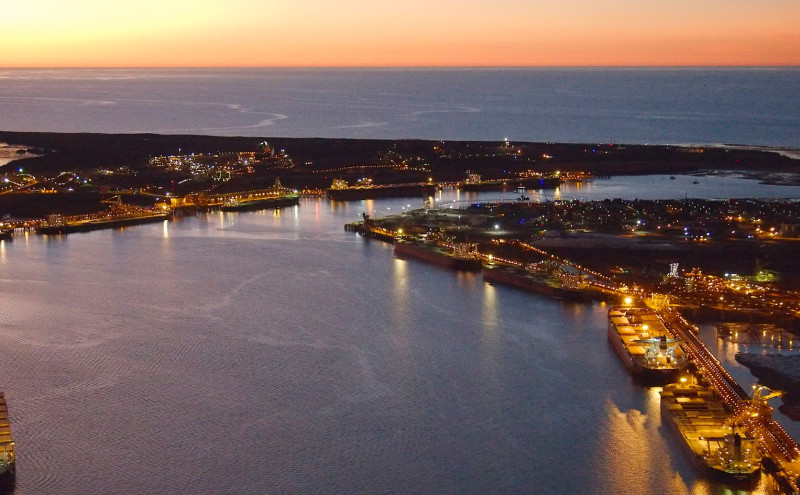A combination of public and private funding is delivering these projects, many of which involve Port Hedland Industries Council members BHP, Fortescue, Roy Hill, Pilbara Ports Authority, Mineral Resources, Consolidated Minerals, Pilbara Minerals, and Sandfire Resources.
Underpinning this progress is a revised Port of Port Hedland development plan endorsed by the State Government earlier this year that will enable the growth of iron ore exports to 660 million tonnes a year.
It allows for:
- A new iron ore export berth at Stanley Point Berth 3.
- A future bulk liquids berth in South West Creek.
- The development of a second general cargo berth at Lumsden Point.
- Increased capacity allocations of approximately 25 per cent for existing port proponents BHP, Fortescue, and Roy Hill.
- Future development of Stanley Point Berth 3 allocated to a joint venture between Hancock Prospecting Pty Ltd and Mineral Resources, pending approvals.
- A new Fortescue shiploader on Anderson Point Berth 5 to support exports from the Iron Bridge project.
PHIC Chief Executive Officer Kirsty Danby said the State Government’s endorsement of the port development plan, which was last updated in 2012, was a major step forward for the town and port users.
“Pilbara Ports Authority staff are to be congratulated for the work they put in to have this plan endorsed,” Danby said.
“It will allow port users to develop their growth strategies and to invest in landside infrastructure, which is good for Port Hedland, the port users, and the State.
“But the activity is not restricted to iron ore. Exports of futurefacing minerals are increasing, and direct shipping links are expanding, providing mining and non-mining businesses with access to new transportation options for supply and delivery.”
While recognised as the iron ore capital of Australia, Port Hedland is also home to lithium and manganese exporters and could be the location for a potential billion-dollar lithium plant.
British company Alkemy Capital Investments is proposing to build a four-train lithium-sulphate refinery at Port Hedland as part of a plan to supply Europe’s emerging electric vehicle battery market.
While Alkemy is yet to determine a location for the refinery, it is looking to take advantage of Lumsden Point.
The State Government has allocated $78 million to the port development which will facilitate the export of battery metals such as lithium and copper concentrates, the import of renewable energy infrastructure, including wind turbines and blades, as well as support the rapid growth of direct shipping services to the Pilbara.
Meanwhile, Korean steelmaker Posco and the Hancock Group have launched a feasibility study for a Hot Briquetted Iron plant in Port Hedland fuelled by green hydrogen.
But Port Hedland is not just about industrial infrastructure.
Work is well advanced on the $187.5 million Spoilbank Marina project, with PPA awarding the last of the contract packages, for landscaping, as it works to deliver the project next year.
This new facility will be enjoyed by the Port Hedland community and visitors and will alleviate demand on existing boat launching facilities and improve access and safety for recreational boaters.
The project is managed and delivered by PPA in collaboration with the Department of Transport, DevelopmentWA, Pilbara Development Commission, BHP, and the Town of Port Hedland, and is funded by the State Government, Town of Port Hedland and BHP.
The marina is expected to be operational in late 2023.
The Port Hedland Voluntary Buyback Scheme continues, as the first step to creating a new West End focused on developing a Maritime Precinct that includes commercial, leisure, tourist, cultural, training, educational and other land uses.
An important part of the new West End will be a Seafarers Centre, replacing the existing headquarters, which were built in the 1960s and are no longer fit for purpose.
Before COVID-19, more than 3000 seafarers visited the centre each month. While seafarers were prevented from venturing onshore during the worst of the pandemic, the good news is that they are once again able to come ashore and visit the town.
The new Seafarers’ Centre will be built on the former Sealanes site on Richardson Street.
Elsewhere, the second stage expansion and redevelopment of the JD Hardie Youth and Community Hub in South Hedland has been officially opened.
The $7.5 million investment towards the second stage development was primarily funded by the Town of Port Hedland, with $750,000 provided through the Department of Local Government, Sport and Cultural Industries’ Community Sporting and Recreation Facilities Fund.
The Port Hedland Town Council has endorsed plans for a fivestage, $250 million integrated sporting hub in South Hedland.
And in keeping with the theme of revitalisation, the exterior of the landmark 118-year-old Esplanade Hotel is getting a makeover.
Owned by BHP, the hotel’s existing cladding will be removed to replace the external facing facades with a new render finish aligned to the building’s heritage values.
“Port Hedland is looking to the future — and there’s a lot to see,” Danby said.





